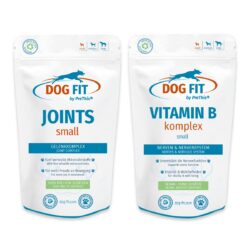Cauda equina syndrome in dogs

What is Cauda Equina Syndrome?
Cauda equina syndrome (also called degenerative lumbosacral stenosis, DLSS) is a neurological disorder of the lumbar spine in which the nerve roots at the junction between the lumbar spine and sacrum are affected. This region, the so-called cauda equina (“horse’s tail”), contains numerous important nerve strands that supply the hindquarters, the tail, and parts of the pelvic floor. If these nerves become constricted (stenosis) or irritated, complex symptoms can arise that significantly impair the dog’s quality of life.
Causes and risk factors
The causes of cauda equina syndrome are diverse and primarily affect medium to large dog breeds – for example, German Shepherds, Labrador Retrievers, or Boxers. Risk factors include:
- Age-related wear and tear of the vertebral joints and intervertebral discs: With increasing age, the structures of the spine become less elastic and can narrow or harden.
- Herniated discs in the lumbar region: These can put pressure on the nerves of the cauda equina.
- Spondylosis (ossification of the vertebral joints): Contributes to the narrowing of the spinal canal.
- Genetic predisposition: Certain dog breeds have an increased risk of this disease.
- Chronic over- or incorrect strain: Being overweight, strenuous exercise, or frequent jumping and climbing stairs can contribute to the problem.
Link to scientific Study.
Cauda Equina – Typical Symptoms
Cauda equina syndrome usually manifests itself through the following signs, which can occur individually or in combination:
- Lower back pain: Often visible when standing up, sitting down, or climbing stairs.
- Altered movement: Lameness, stiff or wobbly gait, avoidance of certain movements.
- Restricted tail mobility: The tail is moved less or hangs limply.
- Difficulty urinating or defecating: Incontinence or difficult defecation are possible.
- Neurological abnormalities: Tremors, coordination problems, unsteadiness when standing or walking.
- Muscle atrophy in the hind legs: Reduced use can cause the muscles to atrophy.
Not all symptoms always occur simultaneously. Especially in the early stages, they are often nonspecific and easily confused with other diseases.
Diagnosis and Differentiation
Since many diseases of the musculoskeletal system can cause similar symptoms, an accurate diagnosis is particularly important. Diagnosis is usually made through a combination of:
- Thorough clinical examination: Recording pain reactions, reflexes, and movement patterns.
- Imaging techniques: X-rays, CT scans, or MRIs provide detailed images of the condition of vertebrae, intervertebral discs, and nerves.
- Neurological testing: Testing reflexes and sensitivity in the hind legs and pelvic area.
Differentiating from other diseases such as herniated discs, spondylosis, or hip dysplasia is essential for appropriate treatment.
Therapeutic approaches and everyday life
Treatment of cauda equina syndrome depends on the severity of the symptoms and should always be individually tailored by the veterinarian. Possible options include:
- Medicinal therapy: Painkillers and anti-inflammatory medications to relieve acute symptoms.
- Physiotherapy: Targeted exercise, massage, underwater treadmill, and passive mobilization to promote mobility and relieve pain.
- Weight management: A slim body shape reduces stress on the spine.
- Limitation of weight-bearing activities: Avoiding stairs, jumping, and sudden movements.
- Surgical treatment: In severe or advanced cases, surgery may be necessary to relieve compressed nerves. The prognosis depends on the extent of the damage and the speed of the intervention.
Important: With early detection and consistent treatment, the prognosis is often good – many dogs can lead a worthwhile, active life.
Role of nutrition and micronutrients
A balanced diet is important to support general well-being and the function of the musculoskeletal system. In consultation with your veterinarian, targeted supplementation with selected micronutrients can be helpful in supporting the physiological function of nerves, muscles, connective tissue, and intervertebral discs.
Everyday Tips for Dog Owners
- Provide non-slip surfaces so your dog can walk safely.
- Set up a comfortable, warm place to lie down.
- Plan walks individually and in consultation with your veterinarian.
- Excessive jumping, hopping, or climbing stairs should be avoided.
- Regular veterinary check-ups help monitor the progression.
Important Note
The care of dogs with Cauda Equina Syndrome should always be individualized and under veterinary supervision. Observe changes in movement behavior and consult your veterinarian early on if you have any concerns.
